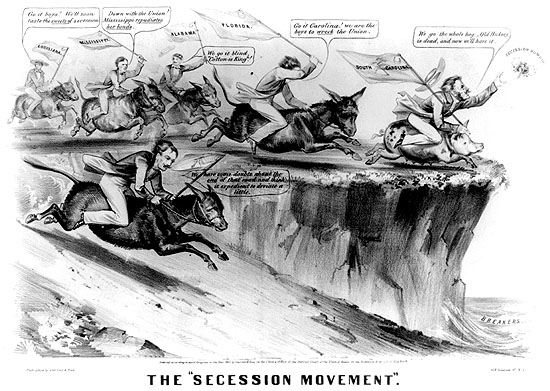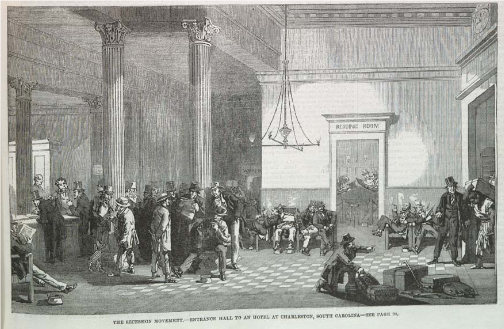I. Southern Secession
A. Secession in the Deep South – the Cotton Belt states with large numbers of large slaveholders—South Carolina, Mississippi, Alabama, Georgia, Florida, Louisiana, and Texas—were the first states to secede from the Union.
1. Reasons for secession in the Deep South
a. Republican promises to end expansion of slavery – the founding principle of the Republican Party was ending the expansion of slavery to areas outside the current slaveholding states. Without the ability to expand slavery, slaveholders would become a political minority, which would endanger the institution of slavery. Ending the expansion of slavery would also undermine slavery because it would prevent hopes of upward mobility for small slaveholders.
b. Slavery laws ignored by Republicans – since the Fugitive Slave Law, as well as the Dred Scott decision, were not enforced in areas in the North controlled by Republicans, southern planters feared that the assurances that Lincoln was giving over his lack of desire to interfere with the institution of slavery as it then stood were insincere, and that if they remained in the Union slavery would eventually be abolished as soon as the Republicans had the votes to do so.
c. Southern fears of slave uprisings – the ghost of John Brown haunted the South after his death. Southerners feared that having an anti-slavery figure at the head of the federal government would foment rebellion amongst their slaves—that northern abolitionists would be emboldened to infiltrate the South to encourage this behavior among their otherwise loyal slaves.
2. Southern debate over secession – the elites in the South—and only the elites—debated the issue of secession; this debate was less contentious in the Deep South, were large planters dominated the state legislators; the debate was more contentious in the Upper South, where the large slave owners were less numerous—and the realization that their states were likely to see the majority of the military action—made secession less appealing.
a. No popular vote over the issue – only in the state of Texas were voters allowed to vote on the issue of secession.
b. Little confidence in the ability of the “common people” – As a legislator from South Carolina put it, “But who ever waited for the common people when a great movement was to be made? We must make the move and force them to follow.” (Quote from page 599 in textbook) Southern economic and political elites probably also feared that if the issue was put to a vote, there would not be any popular support.
c. Appeals to Southern racism – southern elites also appealed to the baser fears of their fellow southerners, with threats of miscegenation that would follow if Republican efforts to free the slaves were successful.
B. Northern Reaction to Southern Demands – there were three areas of reaction in the North to the demands the South made to remain in the Union; those who believed in peace at any price (led by northern industrialists who relied upon the money that southern cotton generated); abolitionists, who believed that union with slaveholders was an unholy alliance, and would rather see the union ended than continue with in conjunction with slaveholding; and people who occupied the middle ground on this issue (like Lincoln himself), who believed that compromise with the South could be reached.
1. Bankers, Merchants, Industrialists—and Workers –Bankers (who had lent large sums of money to southern planters), Merchants (who traded the raw cotton grown in the South), Industrialists (who relied upon cotton to furnish their textile mills with raw material) all saw their economic interests imperiled by the threat of war.
a. Workers – also saw their economic well being endangered, if the manufacturing interests of the country were interrupted.
2. Loyalty to the Union – many of these people were also influenced by their loyalty to the Union—the system of government which they believed to be the greatest system of government created.
C. Lincoln’s Balancing Act – most of Lincoln’s actions during the early period of this crisis were governed by his desire to keep other southern states from following the example of the initial seven states. Lincoln had to maintain this balancing act even after the secession of Virginia, Arkansas Tennessee, and North Carolina because he wanted to ensure that the slaveholding states that remained in the Union—Maryland, Delaware, Kentucky, and Missouri—did remain. This was not only keep these states from seceding, but also to keep a lid on “butternuts” (or, as they became known during the war years, “copperheads,” in the Midwest border states—Ohio, Indiana, and Illinois—from joining with the southerners that they sympathized with.
1. Assurances about slaveholding – Lincoln tried to assure slaveholders in border states that the federal government would not interfere with their rights as slaveholders (This was the carrot)
2. Quashing dissent – Lincoln was not above using force to quash dissent once hostilities warmed up and the fighting of the war began.
a. Vallandigham – Clement Vallandigham, from the great state of Ohio, was a leader of the Copperhead faction of the Democratic Party (called Copperheads after the poisonous snake), the less than loyal faction in government. Lincoln’s threats of arrest eventually forced Vallandigham to flee to Canada.
b. Suspension of Habeas Corpus – Habeas Corpus means literally in Latin to produce the body; in law, the term means that a person cannot be held in jail indefinitely without being charged for a crime. When Lincoln suspended this right, it was used with impunity against political enemies, who were seen as disloyal to the Union cause. (This measure, and other like it, were of course the stick).
II. The Shooting War
A. Firing on Fort Sumter – Lincoln, in his inaugural speech, promised not to be the first to fire in anger, that that burden would fall upon the shoulders of the leaders of the South; however, he also promised to give up no federal property in the process.
1. South Carolina demands that the fort surrender – southerners saw the existence of the fort in the midst of this new nation as an affront, and demanded its removal.
2. Lincoln’s attempted compromise – after much delay, Lincoln announced that the fort would be re-supplied with food, but that no attempt would be made to fortify Sumter with additional men; if the South chose to prevent this from happening, the burden of starting a shooting war would lie with them, not the federal government.
B. Southern War successes – for a variety of reasons, the South enjoyed nearly all the military success in the early years of the war.
1. South fights a defensive war – the South during the war fought to defend its territorial integrity from Northern army, which meant that the Southern armies fought mainly on terrain they were familiar with; the weaknesses of the southern transportation system was neutralized, since the lack of transportation affected both sides; and the fact that Southerners were fighting to defend their homes from the Northern invaders helped initially submerge class differences over the “rich man’s war and the poor man’s fight.”
2. Southern military leaders – the South not only had most of the officers trained at West Point (the United States Military Academy), they also had a cadre of officers trained at military academies in the South, like the Virginia Military Academy and the Citadel. The South was much more militarily oriented, because of the need to direct slave patrols to capture their docile slaves who never ran away, and to provide an outlet for the sons of the planter elite who could not place their sons on their own plantations.
C. Northern Lack of Success – was due largely to the fact that although Northern industrial capability far out-stripped that of the South, that industrial capability needed to be converted to producing war material.
1. Need to fight offensive war on unfamiliar soil – the Northern armies were largely unfamiliar with the terrain in the South, and had to fight the war in the midst of hostile non-belligerents.
2. Lack of competent Northern Military Leaders – northern military leaders tended to emerge from the state or local political elite, most of whom had little or no military experience.
3. Conversion to War Economy – the time that it took northern industry to convert to producing war material coincided with the lack of success that the North experienced.
D. The Slave Labor Action – as the great African American historian W.E.B. DuBois pointed out in Black Reconstruction, one of the great contributing factors to the eventual success of the North was the fact that slaves, when the opportunity presented itself, voted on the continuation of slavery with their feet.
1. War contraband – a policy first developed by Gen. Benjamin Butler in northern Virginia, forced upon him by the large number of slaves who began showing up at Fort Monroe, which he commanded. Butler declared the slaves forfeited by the belligerents, since they were being used to build fortifications, etc., to aid the southern war effort. Not all northern commanders followed Butler’s example, however; a number of slaves were surrendered to their owners when the owner showed up to claim them at the Union Army camps.
III. Conclusion – What They Fought For (before 1863, anyway)
A. The South – to protect their homes, and to preserve their “way of life” (which certainly included slavery, although no one talked about it openly in any fashion, since many soldiers in the field for the South did not own slaves.
B. The North – to preserve the Union, and to preserve their “way of life” (which included, at the very least, not allowing slavery to expand into territory the United States had recently gained—although, again, this was not openly presented as a war aim once the fighting started).








No comments:
Post a Comment